Business Environment Report: Unilever's Structure and PESTLE Analysis
VerifiedAdded on 2022/12/26
|11
|3543
|168
Report
AI Summary
This report provides a comprehensive analysis of Unilever's business environment. It begins with an overview of Unilever, including its history, legal structure, and product offerings. Task 1 describes the company's organizational structure, including the board of directors, executive and non-executive directors, chairperson, and CEO. Task 2 evaluates the importance of the PESTLE (Political, Economic, Social, Technological, Legal, and Environmental) analysis framework for business organizations, emphasizing its cost-effectiveness, ability to provide a 360-degree view of the market, identification of opportunities and threats, and coordination among departments. Task 3 applies the PESTLE framework to analyze Unilever's external environment, detailing political, economic, social, technological, legal, and environmental factors influencing its operations and performance. The report highlights how Unilever uses this tool for strategic planning, business expansion, and adapting to market changes, providing a detailed examination of each factor's impact on the company. Finally, the report concludes with a synthesis of the key findings and their implications for Unilever's future.
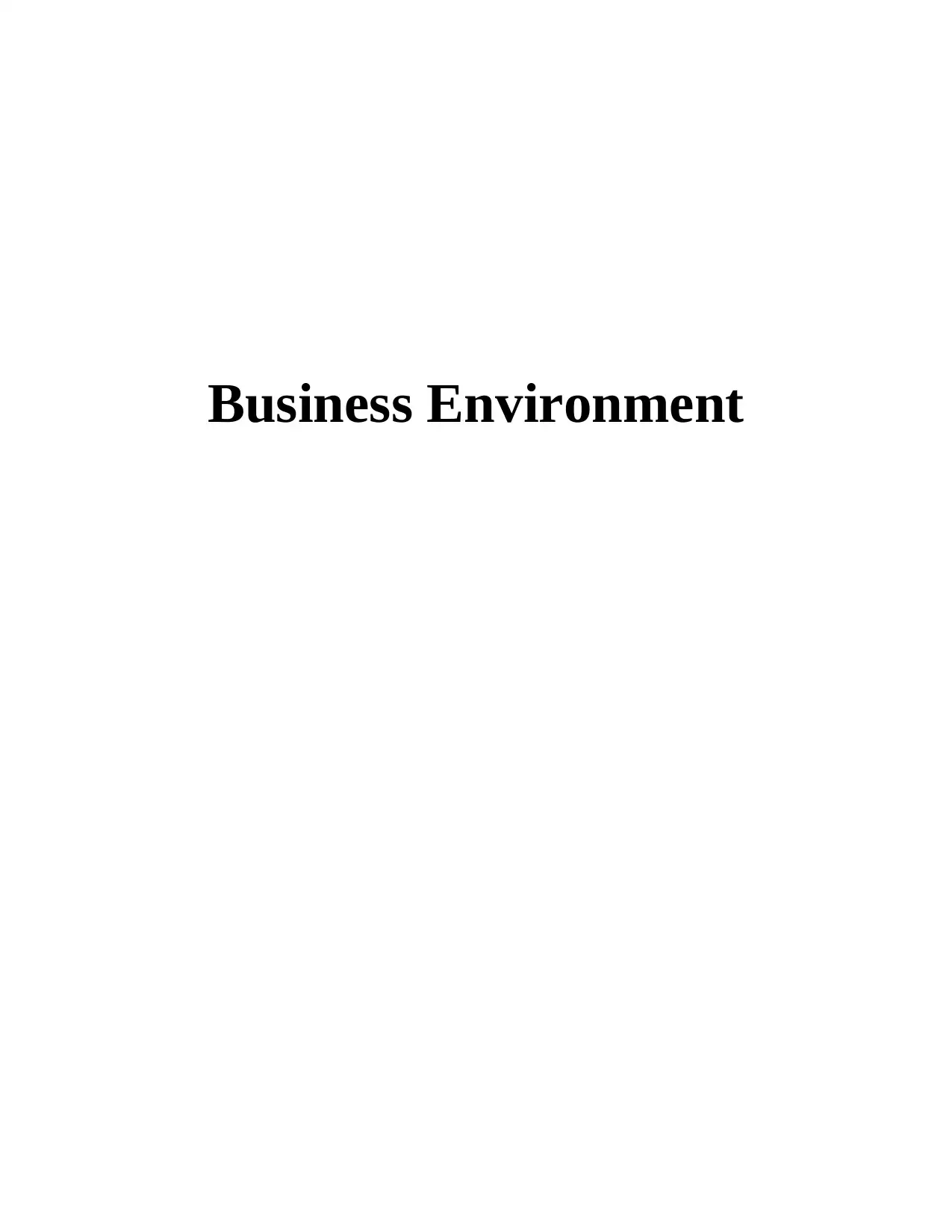
Business Environment
Paraphrase This Document
Need a fresh take? Get an instant paraphrase of this document with our AI Paraphraser

Table of Contents
INTRODUCTION...........................................................................................................................3
Task 1...............................................................................................................................................3
Describe the structure of the company, its management and how it is governed..................3
Task 2 ..............................................................................................................................................5
Evaluate the importance of PESTLE analysis for a business organisation............................5
Task 3...............................................................................................................................................7
Use of PESTLE framework to analyse the external environment of Unilever......................7
Conclusion .....................................................................................................................................9
REFERENCES..............................................................................................................................11
INTRODUCTION...........................................................................................................................3
Task 1...............................................................................................................................................3
Describe the structure of the company, its management and how it is governed..................3
Task 2 ..............................................................................................................................................5
Evaluate the importance of PESTLE analysis for a business organisation............................5
Task 3...............................................................................................................................................7
Use of PESTLE framework to analyse the external environment of Unilever......................7
Conclusion .....................................................................................................................................9
REFERENCES..............................................................................................................................11
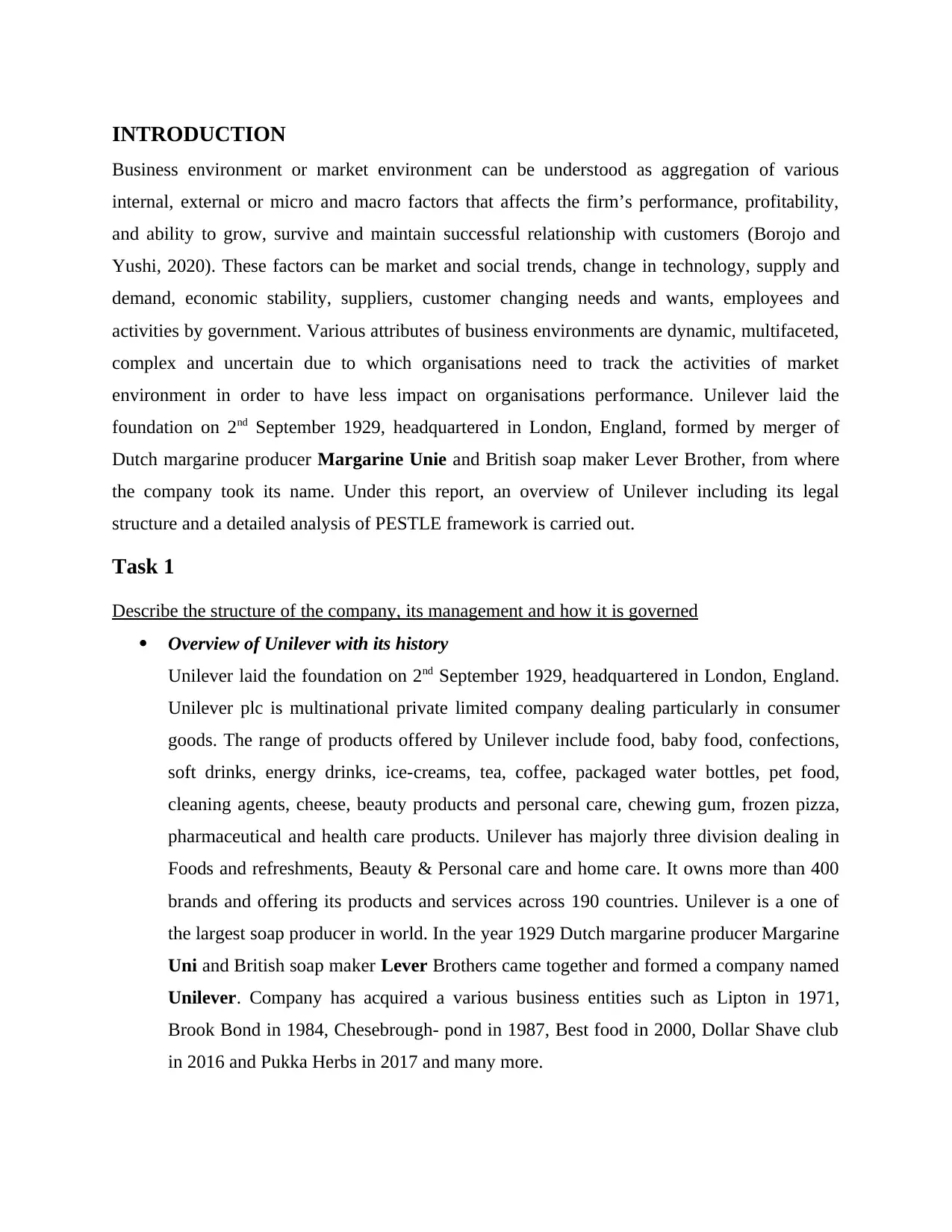
INTRODUCTION
Business environment or market environment can be understood as aggregation of various
internal, external or micro and macro factors that affects the firm’s performance, profitability,
and ability to grow, survive and maintain successful relationship with customers (Borojo and
Yushi, 2020). These factors can be market and social trends, change in technology, supply and
demand, economic stability, suppliers, customer changing needs and wants, employees and
activities by government. Various attributes of business environments are dynamic, multifaceted,
complex and uncertain due to which organisations need to track the activities of market
environment in order to have less impact on organisations performance. Unilever laid the
foundation on 2nd September 1929, headquartered in London, England, formed by merger of
Dutch margarine producer Margarine Unie and British soap maker Lever Brother, from where
the company took its name. Under this report, an overview of Unilever including its legal
structure and a detailed analysis of PESTLE framework is carried out.
Task 1
Describe the structure of the company, its management and how it is governed
Overview of Unilever with its history
Unilever laid the foundation on 2nd September 1929, headquartered in London, England.
Unilever plc is multinational private limited company dealing particularly in consumer
goods. The range of products offered by Unilever include food, baby food, confections,
soft drinks, energy drinks, ice-creams, tea, coffee, packaged water bottles, pet food,
cleaning agents, cheese, beauty products and personal care, chewing gum, frozen pizza,
pharmaceutical and health care products. Unilever has majorly three division dealing in
Foods and refreshments, Beauty & Personal care and home care. It owns more than 400
brands and offering its products and services across 190 countries. Unilever is a one of
the largest soap producer in world. In the year 1929 Dutch margarine producer Margarine
Uni and British soap maker Lever Brothers came together and formed a company named
Unilever. Company has acquired a various business entities such as Lipton in 1971,
Brook Bond in 1984, Chesebrough- pond in 1987, Best food in 2000, Dollar Shave club
in 2016 and Pukka Herbs in 2017 and many more.
Business environment or market environment can be understood as aggregation of various
internal, external or micro and macro factors that affects the firm’s performance, profitability,
and ability to grow, survive and maintain successful relationship with customers (Borojo and
Yushi, 2020). These factors can be market and social trends, change in technology, supply and
demand, economic stability, suppliers, customer changing needs and wants, employees and
activities by government. Various attributes of business environments are dynamic, multifaceted,
complex and uncertain due to which organisations need to track the activities of market
environment in order to have less impact on organisations performance. Unilever laid the
foundation on 2nd September 1929, headquartered in London, England, formed by merger of
Dutch margarine producer Margarine Unie and British soap maker Lever Brother, from where
the company took its name. Under this report, an overview of Unilever including its legal
structure and a detailed analysis of PESTLE framework is carried out.
Task 1
Describe the structure of the company, its management and how it is governed
Overview of Unilever with its history
Unilever laid the foundation on 2nd September 1929, headquartered in London, England.
Unilever plc is multinational private limited company dealing particularly in consumer
goods. The range of products offered by Unilever include food, baby food, confections,
soft drinks, energy drinks, ice-creams, tea, coffee, packaged water bottles, pet food,
cleaning agents, cheese, beauty products and personal care, chewing gum, frozen pizza,
pharmaceutical and health care products. Unilever has majorly three division dealing in
Foods and refreshments, Beauty & Personal care and home care. It owns more than 400
brands and offering its products and services across 190 countries. Unilever is a one of
the largest soap producer in world. In the year 1929 Dutch margarine producer Margarine
Uni and British soap maker Lever Brothers came together and formed a company named
Unilever. Company has acquired a various business entities such as Lipton in 1971,
Brook Bond in 1984, Chesebrough- pond in 1987, Best food in 2000, Dollar Shave club
in 2016 and Pukka Herbs in 2017 and many more.
⊘ This is a preview!⊘
Do you want full access?
Subscribe today to unlock all pages.

Trusted by 1+ million students worldwide
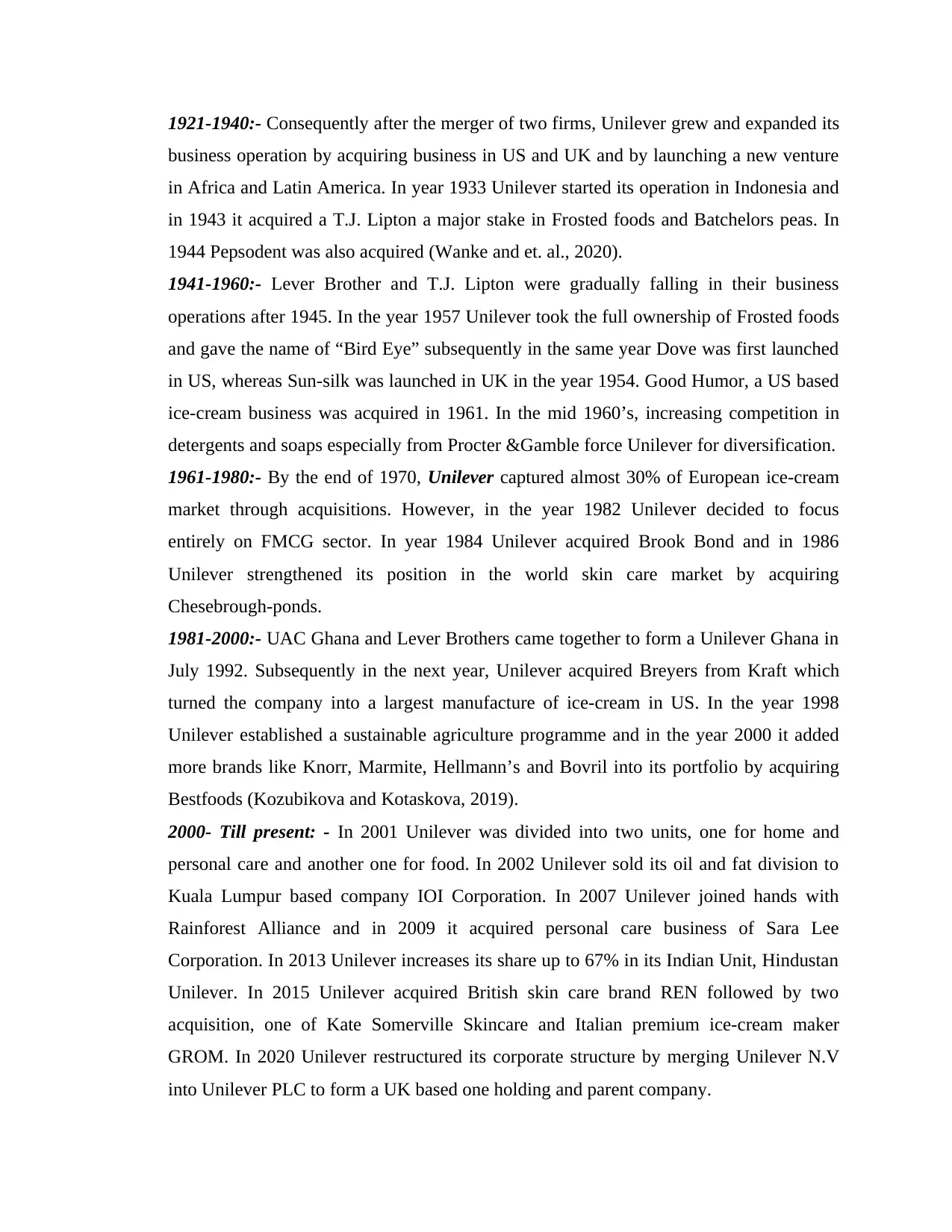
1921-1940:- Consequently after the merger of two firms, Unilever grew and expanded its
business operation by acquiring business in US and UK and by launching a new venture
in Africa and Latin America. In year 1933 Unilever started its operation in Indonesia and
in 1943 it acquired a T.J. Lipton a major stake in Frosted foods and Batchelors peas. In
1944 Pepsodent was also acquired (Wanke and et. al., 2020).
1941-1960:- Lever Brother and T.J. Lipton were gradually falling in their business
operations after 1945. In the year 1957 Unilever took the full ownership of Frosted foods
and gave the name of “Bird Eye” subsequently in the same year Dove was first launched
in US, whereas Sun-silk was launched in UK in the year 1954. Good Humor, a US based
ice-cream business was acquired in 1961. In the mid 1960’s, increasing competition in
detergents and soaps especially from Procter &Gamble force Unilever for diversification.
1961-1980:- By the end of 1970, Unilever captured almost 30% of European ice-cream
market through acquisitions. However, in the year 1982 Unilever decided to focus
entirely on FMCG sector. In year 1984 Unilever acquired Brook Bond and in 1986
Unilever strengthened its position in the world skin care market by acquiring
Chesebrough-ponds.
1981-2000:- UAC Ghana and Lever Brothers came together to form a Unilever Ghana in
July 1992. Subsequently in the next year, Unilever acquired Breyers from Kraft which
turned the company into a largest manufacture of ice-cream in US. In the year 1998
Unilever established a sustainable agriculture programme and in the year 2000 it added
more brands like Knorr, Marmite, Hellmann’s and Bovril into its portfolio by acquiring
Bestfoods (Kozubikova and Kotaskova, 2019).
2000- Till present: - In 2001 Unilever was divided into two units, one for home and
personal care and another one for food. In 2002 Unilever sold its oil and fat division to
Kuala Lumpur based company IOI Corporation. In 2007 Unilever joined hands with
Rainforest Alliance and in 2009 it acquired personal care business of Sara Lee
Corporation. In 2013 Unilever increases its share up to 67% in its Indian Unit, Hindustan
Unilever. In 2015 Unilever acquired British skin care brand REN followed by two
acquisition, one of Kate Somerville Skincare and Italian premium ice-cream maker
GROM. In 2020 Unilever restructured its corporate structure by merging Unilever N.V
into Unilever PLC to form a UK based one holding and parent company.
business operation by acquiring business in US and UK and by launching a new venture
in Africa and Latin America. In year 1933 Unilever started its operation in Indonesia and
in 1943 it acquired a T.J. Lipton a major stake in Frosted foods and Batchelors peas. In
1944 Pepsodent was also acquired (Wanke and et. al., 2020).
1941-1960:- Lever Brother and T.J. Lipton were gradually falling in their business
operations after 1945. In the year 1957 Unilever took the full ownership of Frosted foods
and gave the name of “Bird Eye” subsequently in the same year Dove was first launched
in US, whereas Sun-silk was launched in UK in the year 1954. Good Humor, a US based
ice-cream business was acquired in 1961. In the mid 1960’s, increasing competition in
detergents and soaps especially from Procter &Gamble force Unilever for diversification.
1961-1980:- By the end of 1970, Unilever captured almost 30% of European ice-cream
market through acquisitions. However, in the year 1982 Unilever decided to focus
entirely on FMCG sector. In year 1984 Unilever acquired Brook Bond and in 1986
Unilever strengthened its position in the world skin care market by acquiring
Chesebrough-ponds.
1981-2000:- UAC Ghana and Lever Brothers came together to form a Unilever Ghana in
July 1992. Subsequently in the next year, Unilever acquired Breyers from Kraft which
turned the company into a largest manufacture of ice-cream in US. In the year 1998
Unilever established a sustainable agriculture programme and in the year 2000 it added
more brands like Knorr, Marmite, Hellmann’s and Bovril into its portfolio by acquiring
Bestfoods (Kozubikova and Kotaskova, 2019).
2000- Till present: - In 2001 Unilever was divided into two units, one for home and
personal care and another one for food. In 2002 Unilever sold its oil and fat division to
Kuala Lumpur based company IOI Corporation. In 2007 Unilever joined hands with
Rainforest Alliance and in 2009 it acquired personal care business of Sara Lee
Corporation. In 2013 Unilever increases its share up to 67% in its Indian Unit, Hindustan
Unilever. In 2015 Unilever acquired British skin care brand REN followed by two
acquisition, one of Kate Somerville Skincare and Italian premium ice-cream maker
GROM. In 2020 Unilever restructured its corporate structure by merging Unilever N.V
into Unilever PLC to form a UK based one holding and parent company.
Paraphrase This Document
Need a fresh take? Get an instant paraphrase of this document with our AI Paraphraser
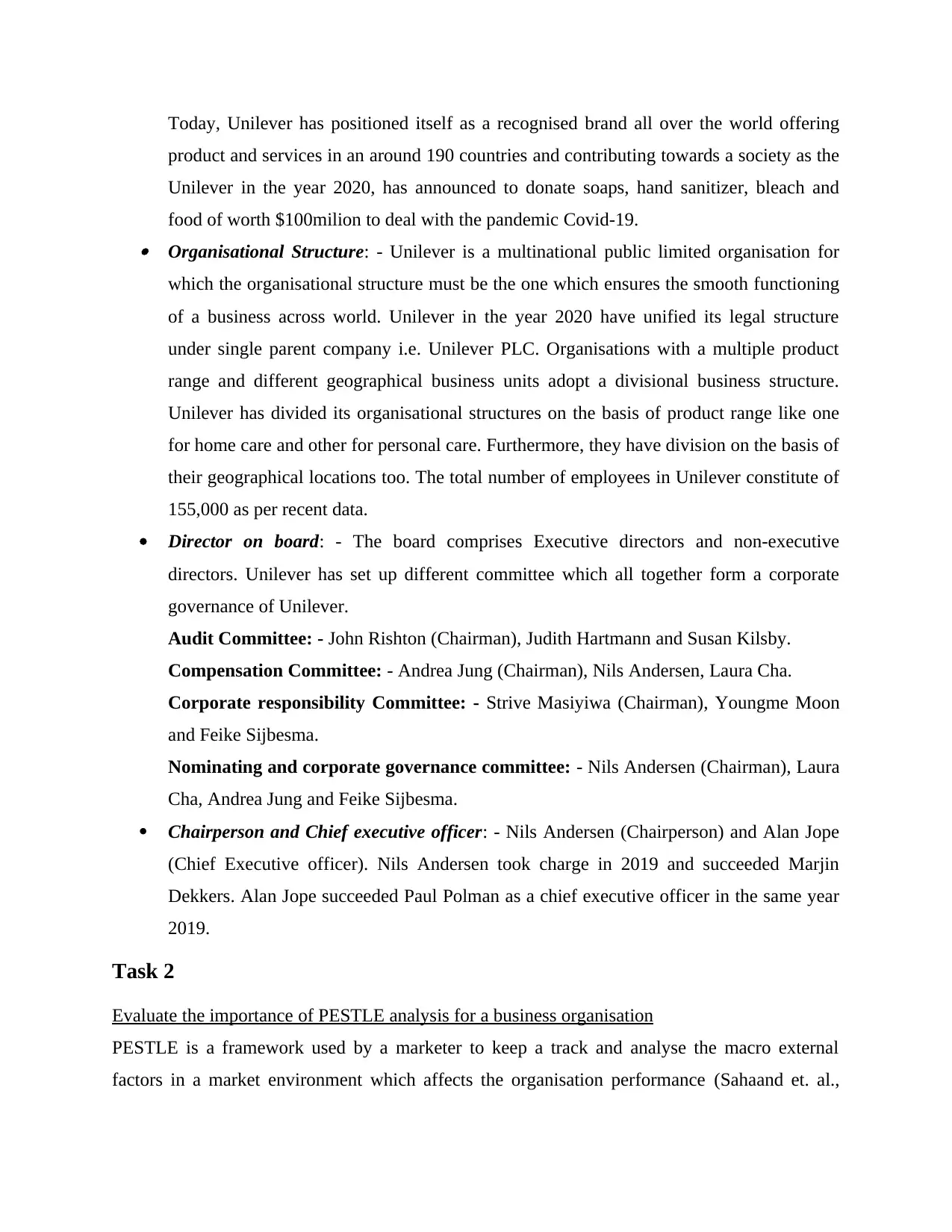
Today, Unilever has positioned itself as a recognised brand all over the world offering
product and services in an around 190 countries and contributing towards a society as the
Unilever in the year 2020, has announced to donate soaps, hand sanitizer, bleach and
food of worth $100milion to deal with the pandemic Covid-19. Organisational Structure: - Unilever is a multinational public limited organisation for
which the organisational structure must be the one which ensures the smooth functioning
of a business across world. Unilever in the year 2020 have unified its legal structure
under single parent company i.e. Unilever PLC. Organisations with a multiple product
range and different geographical business units adopt a divisional business structure.
Unilever has divided its organisational structures on the basis of product range like one
for home care and other for personal care. Furthermore, they have division on the basis of
their geographical locations too. The total number of employees in Unilever constitute of
155,000 as per recent data.
Director on board: - The board comprises Executive directors and non-executive
directors. Unilever has set up different committee which all together form a corporate
governance of Unilever.
Audit Committee: - John Rishton (Chairman), Judith Hartmann and Susan Kilsby.
Compensation Committee: - Andrea Jung (Chairman), Nils Andersen, Laura Cha.
Corporate responsibility Committee: - Strive Masiyiwa (Chairman), Youngme Moon
and Feike Sijbesma.
Nominating and corporate governance committee: - Nils Andersen (Chairman), Laura
Cha, Andrea Jung and Feike Sijbesma.
Chairperson and Chief executive officer: - Nils Andersen (Chairperson) and Alan Jope
(Chief Executive officer). Nils Andersen took charge in 2019 and succeeded Marjin
Dekkers. Alan Jope succeeded Paul Polman as a chief executive officer in the same year
2019.
Task 2
Evaluate the importance of PESTLE analysis for a business organisation
PESTLE is a framework used by a marketer to keep a track and analyse the macro external
factors in a market environment which affects the organisation performance (Sahaand et. al.,
product and services in an around 190 countries and contributing towards a society as the
Unilever in the year 2020, has announced to donate soaps, hand sanitizer, bleach and
food of worth $100milion to deal with the pandemic Covid-19. Organisational Structure: - Unilever is a multinational public limited organisation for
which the organisational structure must be the one which ensures the smooth functioning
of a business across world. Unilever in the year 2020 have unified its legal structure
under single parent company i.e. Unilever PLC. Organisations with a multiple product
range and different geographical business units adopt a divisional business structure.
Unilever has divided its organisational structures on the basis of product range like one
for home care and other for personal care. Furthermore, they have division on the basis of
their geographical locations too. The total number of employees in Unilever constitute of
155,000 as per recent data.
Director on board: - The board comprises Executive directors and non-executive
directors. Unilever has set up different committee which all together form a corporate
governance of Unilever.
Audit Committee: - John Rishton (Chairman), Judith Hartmann and Susan Kilsby.
Compensation Committee: - Andrea Jung (Chairman), Nils Andersen, Laura Cha.
Corporate responsibility Committee: - Strive Masiyiwa (Chairman), Youngme Moon
and Feike Sijbesma.
Nominating and corporate governance committee: - Nils Andersen (Chairman), Laura
Cha, Andrea Jung and Feike Sijbesma.
Chairperson and Chief executive officer: - Nils Andersen (Chairperson) and Alan Jope
(Chief Executive officer). Nils Andersen took charge in 2019 and succeeded Marjin
Dekkers. Alan Jope succeeded Paul Polman as a chief executive officer in the same year
2019.
Task 2
Evaluate the importance of PESTLE analysis for a business organisation
PESTLE is a framework used by a marketer to keep a track and analyse the macro external
factors in a market environment which affects the organisation performance (Sahaand et. al.,

2021). This framework give a 360 degree of an environment and how they influence the
activities of business. PESTLE is a mnemonic which in a broader term “P” stands for political,
“E” for economic, “S” for social, “T” for technological, “L” for legal and “E” for environmental.
This framework is used by new entrants or the one planning to expand its business operations
which is essential in business and strategic planning, product and business development and
marketing planning.
Importance of PESTLE framework
Cost effectiveness: - PESTLE analysis is all about monitoring and analysing the external
macro factor in a market environment to identify the opportunities and threats for a
business. Developing and implementing the PESTLE framework doesn’t include much
cost and delivers a reliable information which make this tool cost effective for a company
to adopt. PESTLE framework is easy and straightforward to implement and understand
which only requires a detailed research and time to work upon (Onyshchenko, Maslii and
Ivaniuk, 2020).
Better Understanding: - This tool is essential for a business organisation as it provides
360 degree view of a market environment. Without this framework few thing could go
unnoticed which could directly the business operations. This framework ensures
effectiveness of business and strategic planning, planning of product development and
marketing strategies. For example, if a company neglect the social factors while planning
an overseas operation, consequences of which could be loss of financial resources and
failure of business.
Identification of opportunities: - PESTLE framework is used in order to study and
analyse the external environment and look out for a possible opportunities for business
expansion and diversification. By analysing and monitoring the current consumer
behaviour, insights and trends can give a deeper knowledge of customer’s taste, choices
and preferences (Sul, Chi and Han, 2020). According to which company can opt for
development of product and services which could match the needs of the customers.
Technological advancement is another factor that result beneficial for a company. In the
era of technological advancement, there are various innovation which are making the life
of an individual easy and convenient. Business organisations can opt for a social media
activities of business. PESTLE is a mnemonic which in a broader term “P” stands for political,
“E” for economic, “S” for social, “T” for technological, “L” for legal and “E” for environmental.
This framework is used by new entrants or the one planning to expand its business operations
which is essential in business and strategic planning, product and business development and
marketing planning.
Importance of PESTLE framework
Cost effectiveness: - PESTLE analysis is all about monitoring and analysing the external
macro factor in a market environment to identify the opportunities and threats for a
business. Developing and implementing the PESTLE framework doesn’t include much
cost and delivers a reliable information which make this tool cost effective for a company
to adopt. PESTLE framework is easy and straightforward to implement and understand
which only requires a detailed research and time to work upon (Onyshchenko, Maslii and
Ivaniuk, 2020).
Better Understanding: - This tool is essential for a business organisation as it provides
360 degree view of a market environment. Without this framework few thing could go
unnoticed which could directly the business operations. This framework ensures
effectiveness of business and strategic planning, planning of product development and
marketing strategies. For example, if a company neglect the social factors while planning
an overseas operation, consequences of which could be loss of financial resources and
failure of business.
Identification of opportunities: - PESTLE framework is used in order to study and
analyse the external environment and look out for a possible opportunities for business
expansion and diversification. By analysing and monitoring the current consumer
behaviour, insights and trends can give a deeper knowledge of customer’s taste, choices
and preferences (Sul, Chi and Han, 2020). According to which company can opt for
development of product and services which could match the needs of the customers.
Technological advancement is another factor that result beneficial for a company. In the
era of technological advancement, there are various innovation which are making the life
of an individual easy and convenient. Business organisations can opt for a social media
⊘ This is a preview!⊘
Do you want full access?
Subscribe today to unlock all pages.

Trusted by 1+ million students worldwide
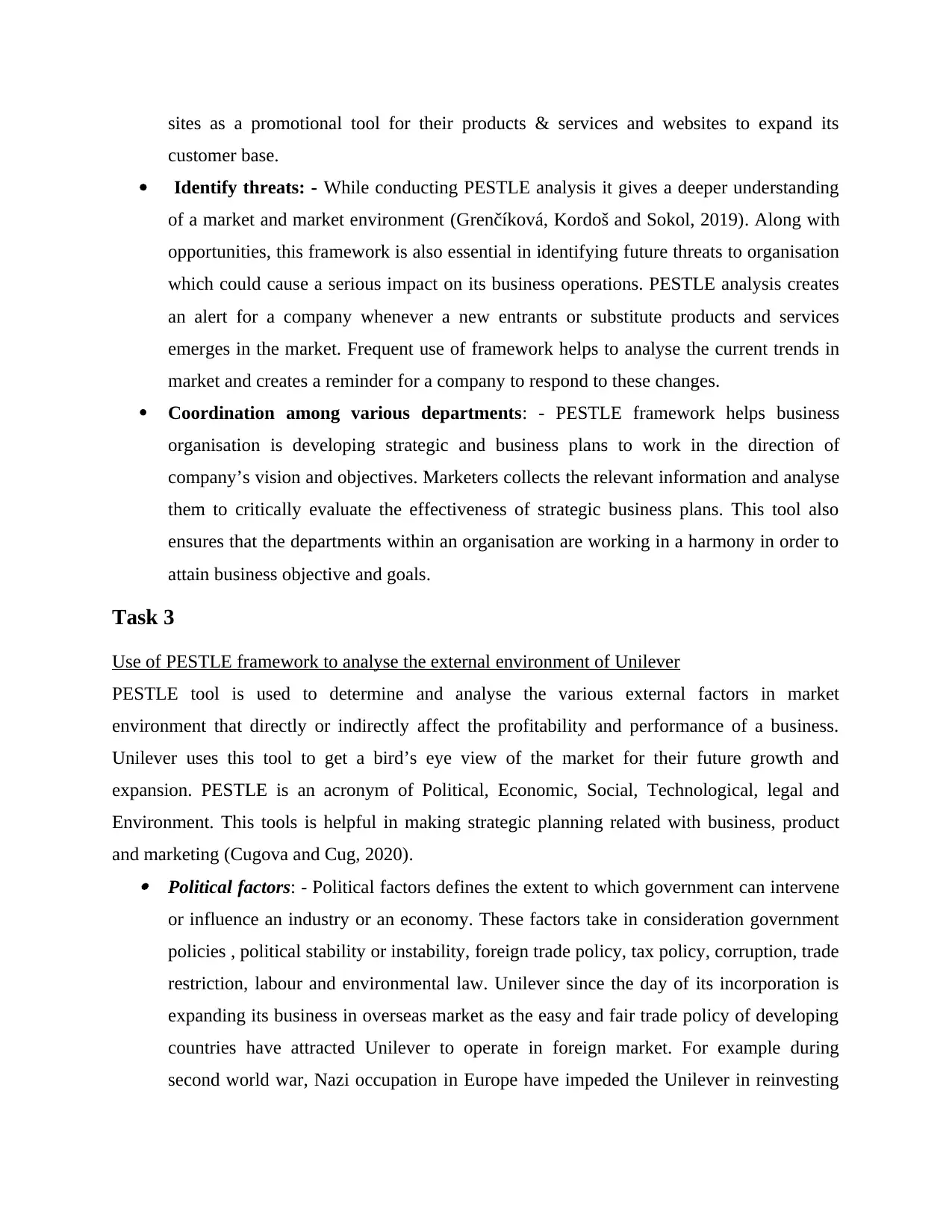
sites as a promotional tool for their products & services and websites to expand its
customer base.
Identify threats: - While conducting PESTLE analysis it gives a deeper understanding
of a market and market environment (Grenčíková, Kordoš and Sokol, 2019). Along with
opportunities, this framework is also essential in identifying future threats to organisation
which could cause a serious impact on its business operations. PESTLE analysis creates
an alert for a company whenever a new entrants or substitute products and services
emerges in the market. Frequent use of framework helps to analyse the current trends in
market and creates a reminder for a company to respond to these changes.
Coordination among various departments: - PESTLE framework helps business
organisation is developing strategic and business plans to work in the direction of
company’s vision and objectives. Marketers collects the relevant information and analyse
them to critically evaluate the effectiveness of strategic business plans. This tool also
ensures that the departments within an organisation are working in a harmony in order to
attain business objective and goals.
Task 3
Use of PESTLE framework to analyse the external environment of Unilever
PESTLE tool is used to determine and analyse the various external factors in market
environment that directly or indirectly affect the profitability and performance of a business.
Unilever uses this tool to get a bird’s eye view of the market for their future growth and
expansion. PESTLE is an acronym of Political, Economic, Social, Technological, legal and
Environment. This tools is helpful in making strategic planning related with business, product
and marketing (Cugova and Cug, 2020). Political factors: - Political factors defines the extent to which government can intervene
or influence an industry or an economy. These factors take in consideration government
policies , political stability or instability, foreign trade policy, tax policy, corruption, trade
restriction, labour and environmental law. Unilever since the day of its incorporation is
expanding its business in overseas market as the easy and fair trade policy of developing
countries have attracted Unilever to operate in foreign market. For example during
second world war, Nazi occupation in Europe have impeded the Unilever in reinvesting
customer base.
Identify threats: - While conducting PESTLE analysis it gives a deeper understanding
of a market and market environment (Grenčíková, Kordoš and Sokol, 2019). Along with
opportunities, this framework is also essential in identifying future threats to organisation
which could cause a serious impact on its business operations. PESTLE analysis creates
an alert for a company whenever a new entrants or substitute products and services
emerges in the market. Frequent use of framework helps to analyse the current trends in
market and creates a reminder for a company to respond to these changes.
Coordination among various departments: - PESTLE framework helps business
organisation is developing strategic and business plans to work in the direction of
company’s vision and objectives. Marketers collects the relevant information and analyse
them to critically evaluate the effectiveness of strategic business plans. This tool also
ensures that the departments within an organisation are working in a harmony in order to
attain business objective and goals.
Task 3
Use of PESTLE framework to analyse the external environment of Unilever
PESTLE tool is used to determine and analyse the various external factors in market
environment that directly or indirectly affect the profitability and performance of a business.
Unilever uses this tool to get a bird’s eye view of the market for their future growth and
expansion. PESTLE is an acronym of Political, Economic, Social, Technological, legal and
Environment. This tools is helpful in making strategic planning related with business, product
and marketing (Cugova and Cug, 2020). Political factors: - Political factors defines the extent to which government can intervene
or influence an industry or an economy. These factors take in consideration government
policies , political stability or instability, foreign trade policy, tax policy, corruption, trade
restriction, labour and environmental law. Unilever since the day of its incorporation is
expanding its business in overseas market as the easy and fair trade policy of developing
countries have attracted Unilever to operate in foreign market. For example during
second world war, Nazi occupation in Europe have impeded the Unilever in reinvesting
Paraphrase This Document
Need a fresh take? Get an instant paraphrase of this document with our AI Paraphraser
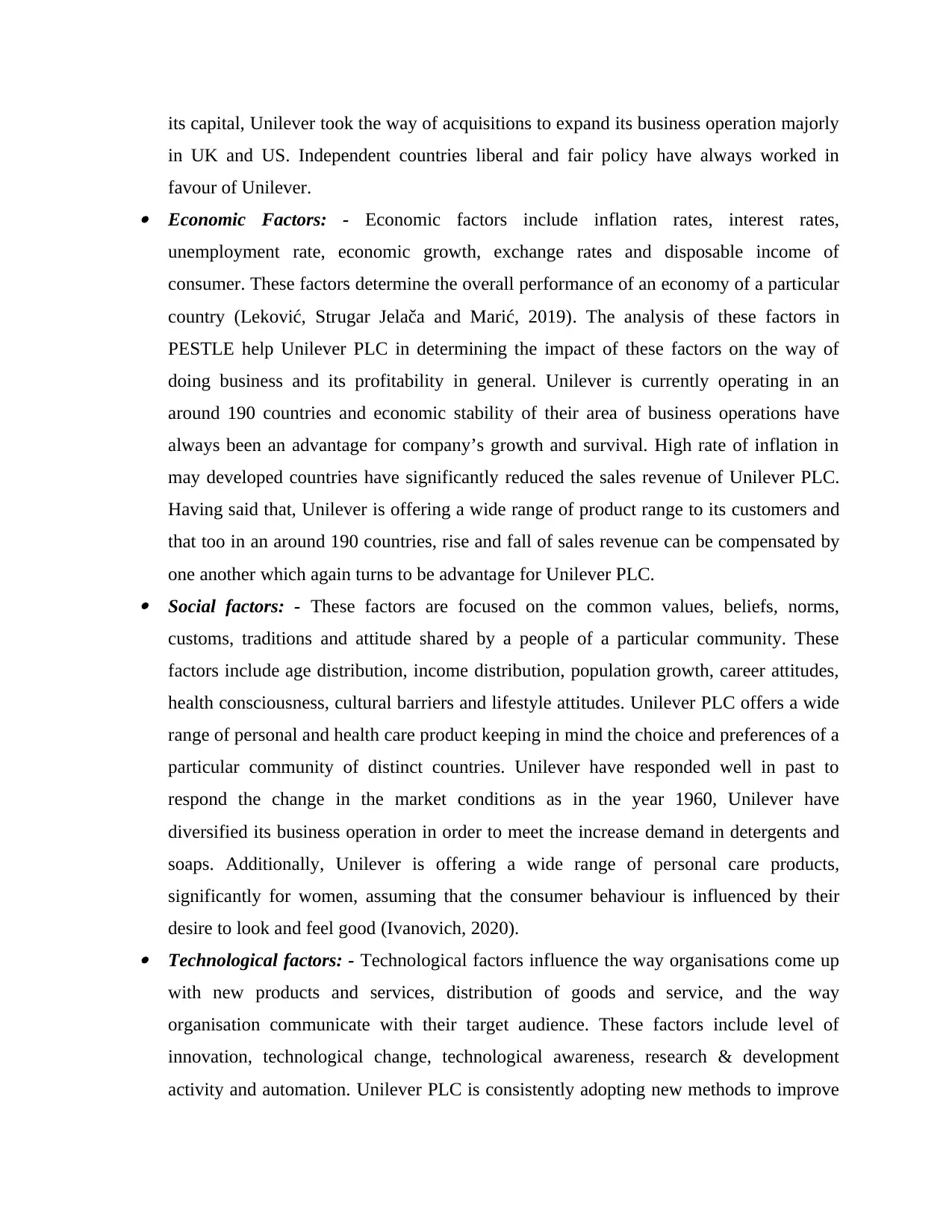
its capital, Unilever took the way of acquisitions to expand its business operation majorly
in UK and US. Independent countries liberal and fair policy have always worked in
favour of Unilever. Economic Factors: - Economic factors include inflation rates, interest rates,
unemployment rate, economic growth, exchange rates and disposable income of
consumer. These factors determine the overall performance of an economy of a particular
country (Leković, Strugar Jelača and Marić, 2019). The analysis of these factors in
PESTLE help Unilever PLC in determining the impact of these factors on the way of
doing business and its profitability in general. Unilever is currently operating in an
around 190 countries and economic stability of their area of business operations have
always been an advantage for company’s growth and survival. High rate of inflation in
may developed countries have significantly reduced the sales revenue of Unilever PLC.
Having said that, Unilever is offering a wide range of product range to its customers and
that too in an around 190 countries, rise and fall of sales revenue can be compensated by
one another which again turns to be advantage for Unilever PLC. Social factors: - These factors are focused on the common values, beliefs, norms,
customs, traditions and attitude shared by a people of a particular community. These
factors include age distribution, income distribution, population growth, career attitudes,
health consciousness, cultural barriers and lifestyle attitudes. Unilever PLC offers a wide
range of personal and health care product keeping in mind the choice and preferences of a
particular community of distinct countries. Unilever have responded well in past to
respond the change in the market conditions as in the year 1960, Unilever have
diversified its business operation in order to meet the increase demand in detergents and
soaps. Additionally, Unilever is offering a wide range of personal care products,
significantly for women, assuming that the consumer behaviour is influenced by their
desire to look and feel good (Ivanovich, 2020). Technological factors: - Technological factors influence the way organisations come up
with new products and services, distribution of goods and service, and the way
organisation communicate with their target audience. These factors include level of
innovation, technological change, technological awareness, research & development
activity and automation. Unilever PLC is consistently adopting new methods to improve
in UK and US. Independent countries liberal and fair policy have always worked in
favour of Unilever. Economic Factors: - Economic factors include inflation rates, interest rates,
unemployment rate, economic growth, exchange rates and disposable income of
consumer. These factors determine the overall performance of an economy of a particular
country (Leković, Strugar Jelača and Marić, 2019). The analysis of these factors in
PESTLE help Unilever PLC in determining the impact of these factors on the way of
doing business and its profitability in general. Unilever is currently operating in an
around 190 countries and economic stability of their area of business operations have
always been an advantage for company’s growth and survival. High rate of inflation in
may developed countries have significantly reduced the sales revenue of Unilever PLC.
Having said that, Unilever is offering a wide range of product range to its customers and
that too in an around 190 countries, rise and fall of sales revenue can be compensated by
one another which again turns to be advantage for Unilever PLC. Social factors: - These factors are focused on the common values, beliefs, norms,
customs, traditions and attitude shared by a people of a particular community. These
factors include age distribution, income distribution, population growth, career attitudes,
health consciousness, cultural barriers and lifestyle attitudes. Unilever PLC offers a wide
range of personal and health care product keeping in mind the choice and preferences of a
particular community of distinct countries. Unilever have responded well in past to
respond the change in the market conditions as in the year 1960, Unilever have
diversified its business operation in order to meet the increase demand in detergents and
soaps. Additionally, Unilever is offering a wide range of personal care products,
significantly for women, assuming that the consumer behaviour is influenced by their
desire to look and feel good (Ivanovich, 2020). Technological factors: - Technological factors influence the way organisations come up
with new products and services, distribution of goods and service, and the way
organisation communicate with their target audience. These factors include level of
innovation, technological change, technological awareness, research & development
activity and automation. Unilever PLC is consistently adopting new methods to improve
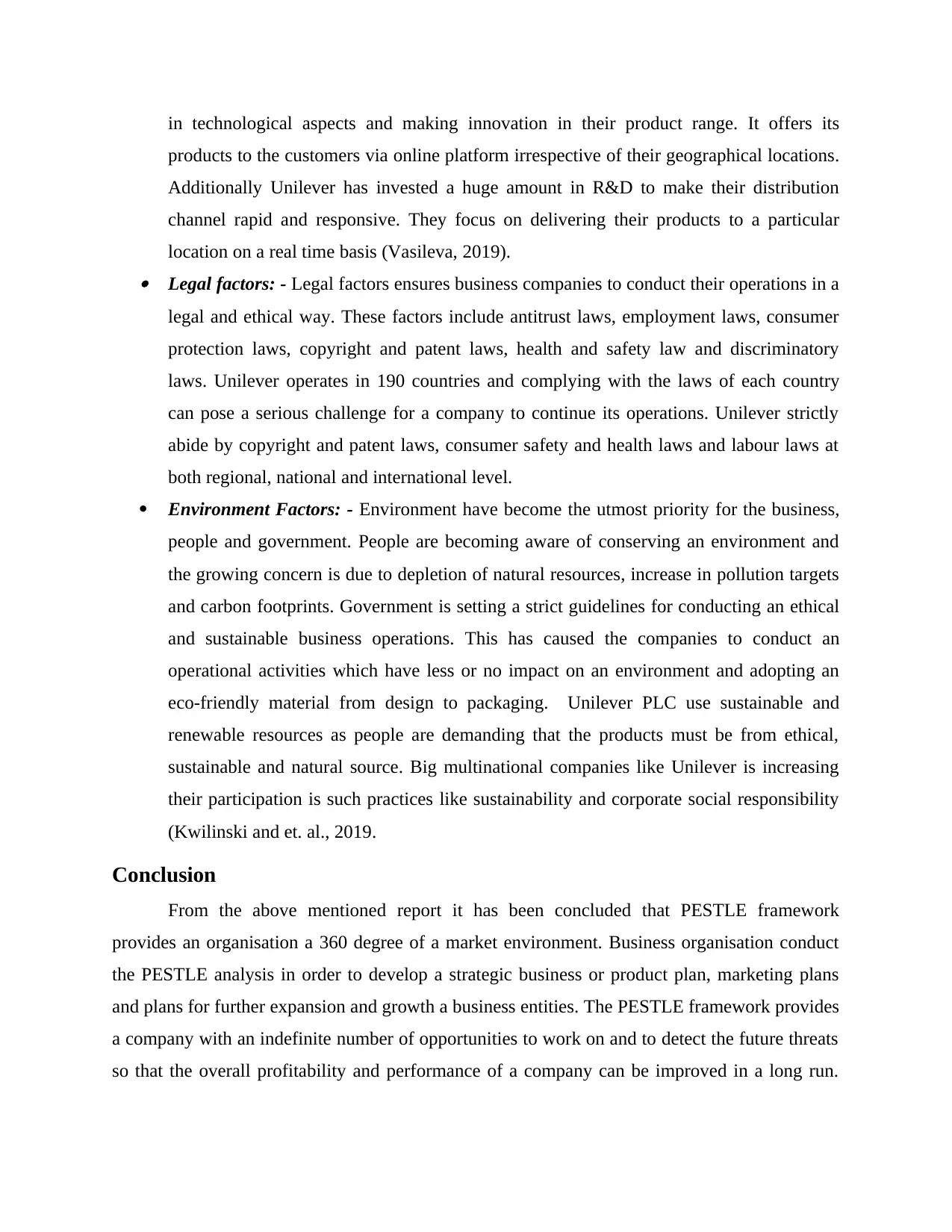
in technological aspects and making innovation in their product range. It offers its
products to the customers via online platform irrespective of their geographical locations.
Additionally Unilever has invested a huge amount in R&D to make their distribution
channel rapid and responsive. They focus on delivering their products to a particular
location on a real time basis (Vasileva, 2019). Legal factors: - Legal factors ensures business companies to conduct their operations in a
legal and ethical way. These factors include antitrust laws, employment laws, consumer
protection laws, copyright and patent laws, health and safety law and discriminatory
laws. Unilever operates in 190 countries and complying with the laws of each country
can pose a serious challenge for a company to continue its operations. Unilever strictly
abide by copyright and patent laws, consumer safety and health laws and labour laws at
both regional, national and international level.
Environment Factors: - Environment have become the utmost priority for the business,
people and government. People are becoming aware of conserving an environment and
the growing concern is due to depletion of natural resources, increase in pollution targets
and carbon footprints. Government is setting a strict guidelines for conducting an ethical
and sustainable business operations. This has caused the companies to conduct an
operational activities which have less or no impact on an environment and adopting an
eco-friendly material from design to packaging. Unilever PLC use sustainable and
renewable resources as people are demanding that the products must be from ethical,
sustainable and natural source. Big multinational companies like Unilever is increasing
their participation is such practices like sustainability and corporate social responsibility
(Kwilinski and et. al., 2019.
Conclusion
From the above mentioned report it has been concluded that PESTLE framework
provides an organisation a 360 degree of a market environment. Business organisation conduct
the PESTLE analysis in order to develop a strategic business or product plan, marketing plans
and plans for further expansion and growth a business entities. The PESTLE framework provides
a company with an indefinite number of opportunities to work on and to detect the future threats
so that the overall profitability and performance of a company can be improved in a long run.
products to the customers via online platform irrespective of their geographical locations.
Additionally Unilever has invested a huge amount in R&D to make their distribution
channel rapid and responsive. They focus on delivering their products to a particular
location on a real time basis (Vasileva, 2019). Legal factors: - Legal factors ensures business companies to conduct their operations in a
legal and ethical way. These factors include antitrust laws, employment laws, consumer
protection laws, copyright and patent laws, health and safety law and discriminatory
laws. Unilever operates in 190 countries and complying with the laws of each country
can pose a serious challenge for a company to continue its operations. Unilever strictly
abide by copyright and patent laws, consumer safety and health laws and labour laws at
both regional, national and international level.
Environment Factors: - Environment have become the utmost priority for the business,
people and government. People are becoming aware of conserving an environment and
the growing concern is due to depletion of natural resources, increase in pollution targets
and carbon footprints. Government is setting a strict guidelines for conducting an ethical
and sustainable business operations. This has caused the companies to conduct an
operational activities which have less or no impact on an environment and adopting an
eco-friendly material from design to packaging. Unilever PLC use sustainable and
renewable resources as people are demanding that the products must be from ethical,
sustainable and natural source. Big multinational companies like Unilever is increasing
their participation is such practices like sustainability and corporate social responsibility
(Kwilinski and et. al., 2019.
Conclusion
From the above mentioned report it has been concluded that PESTLE framework
provides an organisation a 360 degree of a market environment. Business organisation conduct
the PESTLE analysis in order to develop a strategic business or product plan, marketing plans
and plans for further expansion and growth a business entities. The PESTLE framework provides
a company with an indefinite number of opportunities to work on and to detect the future threats
so that the overall profitability and performance of a company can be improved in a long run.
⊘ This is a preview!⊘
Do you want full access?
Subscribe today to unlock all pages.

Trusted by 1+ million students worldwide

This is an cost effective method as it only requires a dedicated time & efforts and could be done
with the help of pen and proper forgo any complex method.
with the help of pen and proper forgo any complex method.
Paraphrase This Document
Need a fresh take? Get an instant paraphrase of this document with our AI Paraphraser
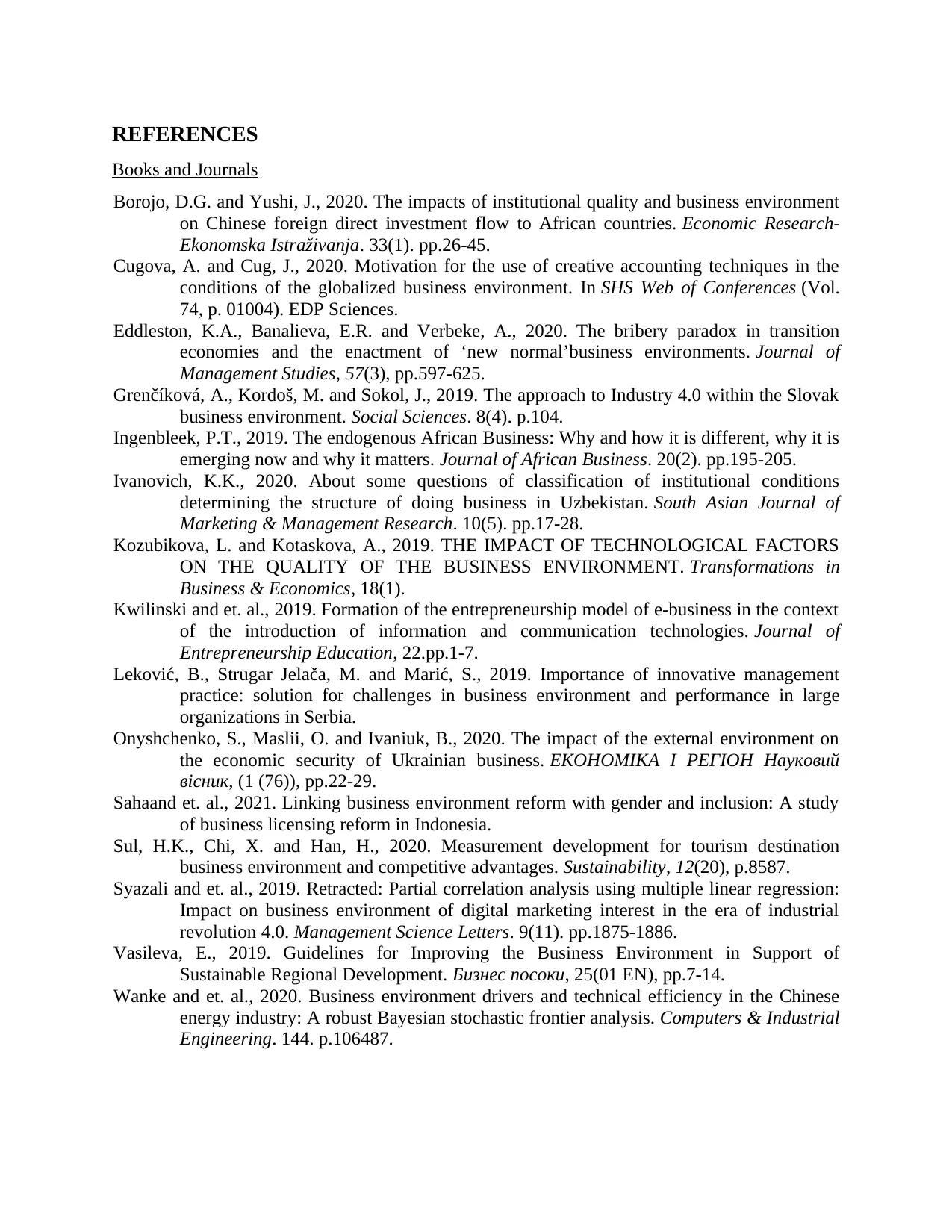
REFERENCES
Books and Journals
Borojo, D.G. and Yushi, J., 2020. The impacts of institutional quality and business environment
on Chinese foreign direct investment flow to African countries. Economic Research-
Ekonomska Istraživanja. 33(1). pp.26-45.
Cugova, A. and Cug, J., 2020. Motivation for the use of creative accounting techniques in the
conditions of the globalized business environment. In SHS Web of Conferences (Vol.
74, p. 01004). EDP Sciences.
Eddleston, K.A., Banalieva, E.R. and Verbeke, A., 2020. The bribery paradox in transition
economies and the enactment of ‘new normal’business environments. Journal of
Management Studies, 57(3), pp.597-625.
Grenčíková, A., Kordoš, M. and Sokol, J., 2019. The approach to Industry 4.0 within the Slovak
business environment. Social Sciences. 8(4). p.104.
Ingenbleek, P.T., 2019. The endogenous African Business: Why and how it is different, why it is
emerging now and why it matters. Journal of African Business. 20(2). pp.195-205.
Ivanovich, K.K., 2020. About some questions of classification of institutional conditions
determining the structure of doing business in Uzbekistan. South Asian Journal of
Marketing & Management Research. 10(5). pp.17-28.
Kozubikova, L. and Kotaskova, A., 2019. THE IMPACT OF TECHNOLOGICAL FACTORS
ON THE QUALITY OF THE BUSINESS ENVIRONMENT. Transformations in
Business & Economics, 18(1).
Kwilinski and et. al., 2019. Formation of the entrepreneurship model of e-business in the context
of the introduction of information and communication technologies. Journal of
Entrepreneurship Education, 22.pp.1-7.
Leković, B., Strugar Jelača, M. and Marić, S., 2019. Importance of innovative management
practice: solution for challenges in business environment and performance in large
organizations in Serbia.
Onyshchenko, S., Maslii, O. and Ivaniuk, B., 2020. The impact of the external environment on
the economic security of Ukrainian business. ЕКОНОМІКА І РЕГІОН Науковий
вісник, (1 (76)), pp.22-29.
Sahaand et. al., 2021. Linking business environment reform with gender and inclusion: A study
of business licensing reform in Indonesia.
Sul, H.K., Chi, X. and Han, H., 2020. Measurement development for tourism destination
business environment and competitive advantages. Sustainability, 12(20), p.8587.
Syazali and et. al., 2019. Retracted: Partial correlation analysis using multiple linear regression:
Impact on business environment of digital marketing interest in the era of industrial
revolution 4.0. Management Science Letters. 9(11). pp.1875-1886.
Vasileva, E., 2019. Guidelines for Improving the Business Environment in Support of
Sustainable Regional Development. Бизнес посоки, 25(01 EN), pp.7-14.
Wanke and et. al., 2020. Business environment drivers and technical efficiency in the Chinese
energy industry: A robust Bayesian stochastic frontier analysis. Computers & Industrial
Engineering. 144. p.106487.
Books and Journals
Borojo, D.G. and Yushi, J., 2020. The impacts of institutional quality and business environment
on Chinese foreign direct investment flow to African countries. Economic Research-
Ekonomska Istraživanja. 33(1). pp.26-45.
Cugova, A. and Cug, J., 2020. Motivation for the use of creative accounting techniques in the
conditions of the globalized business environment. In SHS Web of Conferences (Vol.
74, p. 01004). EDP Sciences.
Eddleston, K.A., Banalieva, E.R. and Verbeke, A., 2020. The bribery paradox in transition
economies and the enactment of ‘new normal’business environments. Journal of
Management Studies, 57(3), pp.597-625.
Grenčíková, A., Kordoš, M. and Sokol, J., 2019. The approach to Industry 4.0 within the Slovak
business environment. Social Sciences. 8(4). p.104.
Ingenbleek, P.T., 2019. The endogenous African Business: Why and how it is different, why it is
emerging now and why it matters. Journal of African Business. 20(2). pp.195-205.
Ivanovich, K.K., 2020. About some questions of classification of institutional conditions
determining the structure of doing business in Uzbekistan. South Asian Journal of
Marketing & Management Research. 10(5). pp.17-28.
Kozubikova, L. and Kotaskova, A., 2019. THE IMPACT OF TECHNOLOGICAL FACTORS
ON THE QUALITY OF THE BUSINESS ENVIRONMENT. Transformations in
Business & Economics, 18(1).
Kwilinski and et. al., 2019. Formation of the entrepreneurship model of e-business in the context
of the introduction of information and communication technologies. Journal of
Entrepreneurship Education, 22.pp.1-7.
Leković, B., Strugar Jelača, M. and Marić, S., 2019. Importance of innovative management
practice: solution for challenges in business environment and performance in large
organizations in Serbia.
Onyshchenko, S., Maslii, O. and Ivaniuk, B., 2020. The impact of the external environment on
the economic security of Ukrainian business. ЕКОНОМІКА І РЕГІОН Науковий
вісник, (1 (76)), pp.22-29.
Sahaand et. al., 2021. Linking business environment reform with gender and inclusion: A study
of business licensing reform in Indonesia.
Sul, H.K., Chi, X. and Han, H., 2020. Measurement development for tourism destination
business environment and competitive advantages. Sustainability, 12(20), p.8587.
Syazali and et. al., 2019. Retracted: Partial correlation analysis using multiple linear regression:
Impact on business environment of digital marketing interest in the era of industrial
revolution 4.0. Management Science Letters. 9(11). pp.1875-1886.
Vasileva, E., 2019. Guidelines for Improving the Business Environment in Support of
Sustainable Regional Development. Бизнес посоки, 25(01 EN), pp.7-14.
Wanke and et. al., 2020. Business environment drivers and technical efficiency in the Chinese
energy industry: A robust Bayesian stochastic frontier analysis. Computers & Industrial
Engineering. 144. p.106487.
1 out of 11
Related Documents
Your All-in-One AI-Powered Toolkit for Academic Success.
+13062052269
info@desklib.com
Available 24*7 on WhatsApp / Email
![[object Object]](/_next/static/media/star-bottom.7253800d.svg)
Unlock your academic potential
Copyright © 2020–2025 A2Z Services. All Rights Reserved. Developed and managed by ZUCOL.





